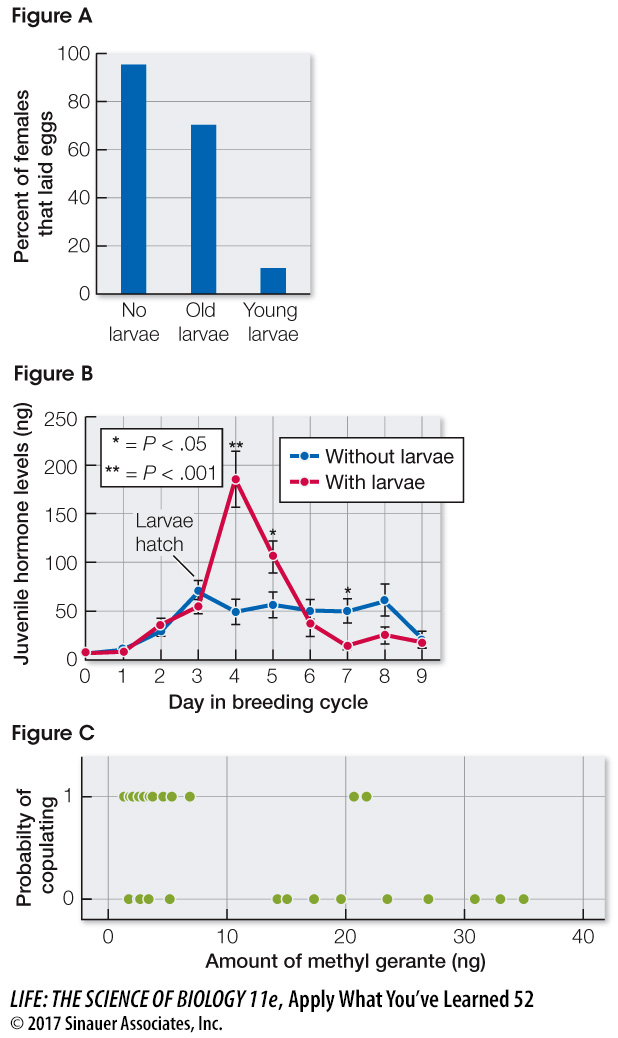Apply What You’ve Learned
Review
52.1
Behaviors have proximate and ultimate causes.
52.3
Hormones influence the development of certain behaviors and their expression at a later time.
52.4
The evolution of behavioral responses to the environment is driven by costs and benefits.
Original Paper: Engel, K. C. et al. 2016. A hormone-
Burying beetles are called nature’s undertakers because they bury the remains of small dead animals. These animal bodies serve as food for the beetles’ young. A mating pair of beetles typically meets over a fresh animal carcass, copulates, and buries the carcass. The female lays fertilized eggs in the soil above the carcass. Some 50–
Researchers used these beetles to study trade-

The researchers measured juvenile hormone (JH) levels present at various times in the breeding cycles of females with and without larvae. Juvenile hormone is known to suppress the fertility of the females. The results are shown in Figure B.
The researchers also measured the effects of a possible pheromone, methyl geranate, on the beetles’ sexual behavior. Methyl geranate is a volatile compound that shares the same biosynthetic pathway with juvenile hormone. The researchers recorded whether or not males copulated with females and the amount of methyl geranate emitted by those females. Figure C summarizes these results. The data points represent meetings resulting in copulation or not.
Questions
1.
What do the data in Figure A indicate about energy trade-
When females have no larvae or old larvae that no longer need parental care, they invest their energy in producing new broods. However, during the short period when larvae are dependent on parental investment (“new larvae”), the female fertility rate is low. Thus females seem to direct their investment of time and energy into the activities most likely to result in reproductive success
2.
Recall that Tinbergen posed two questions about the proximal causes of behavior and two questions as to the ultimate causes of behavior. For the investigation in Question 1 above, decide which question or questions apply. Do these question(s) deal with proximate or ultimate causes of behavior in burying beetles? Explain your answer.
Question 3 of Tinbergen applies. It asks about how a behavior influences survival and reproductive success, and therefore, it deals with ultimate causes of behavior. This study looked into the egg-
3.
What do the data in the Figures B and C indicate about how hormones and pheromones influence burying beetle behavior? What is the biological significance of these results?
The data indicate a correlation between increases in juvenile hormone and suppression of egg-
4.
Refer again to the four questions posed by Tinbergen. For the investigations producing the data in Figures B and C, which question or questions apply? Do these question(s) deal with proximate or ultimate causes of behavior in burying beetles? Explain your answer.
Tinbergen’s question about immediate causation 1 applies, and it deals with proximate causes of behavior. The studies were aimed at elucidating the underlying biological mechanisms that produce the observed changes in behaviors. The results can be used to support the hypothesis that expression of different behaviors comes about as the result of changing levels of hormones and pheromones produced by the female. This is a proximate cause of behavior since it deals with an immediate physiological mechanism that determines how an individual is behaving at a particular time.
5.
Give examples of a cost and a benefit of the parental care behavior of burying beetles.
A cost of the parental care behavior is the opportunity lost for mating and egg laying that could be done instead of caring for young larvae. This means that there are times when the beetles do not actively reproduce, and so fewer offspring are produced over time. A benefit is the protection and nurturing of young larvae, which improves the likelihood that they will survive to carry on the next generation.
Go to LaunchPad for the eBook, LearningCurve, animations, activities, flashcards, and additional resources and assignments.